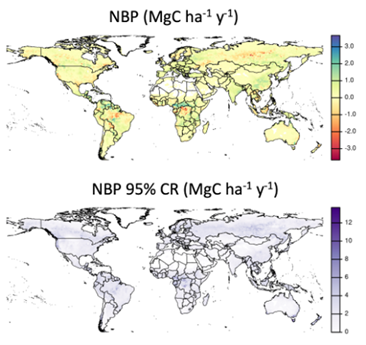
News and Media
Landscape Carbon Dynamics and Modelling

NCEO scientists’ study terrestrial carbon and vegetation using a combination of satellite observations, ground-based measurements, and models.

Carbon (C)-cycling of the land surface is the result of the interplay between C uptake from the atmosphere (e.g. plant photosynthesis), its release back to the atmosphere (e.g. decomposition or fire) processes and mediated by ecological processes at the land surface (e.g. growth and mortality). These interconnected processes and their varied sensitivities to their environment determine whether any given location is net sink or source of C, both now and in the future, in response to changing climate and human management. A detailed understanding of these processes is needed to rigorously determine the current C exchange in space and time, but also in future forecasts which are vital to supporting decision making from field scale land managers to international policy.
Observations, including field and satellite-based discussed above, provide invaluable information the current state of the land surface and, with repeat measurement, on how the land is changing. But observations provide an incomplete view of land surface – missing these internal processes. Computer simulations of the land surface (i.e. models) allow us to mathematically represent a simplified version of the whole system – but require training and evaluation using observations.
NCEO scientists have developed state-of-the-art software (CARDAMOM) to combine observations and model (DALEC). By combining models and observations together we can train our models and bridge the gap between observations creating a complete view of landscape C dynamics with fully realised uncertainties (see figure below).

The above figure shows a CARDAMOM analysis of the global terrestrial ecosystem C-budget (mean 2003-2021). Numbers show the most likely estimate of fluxes (alongside arrows) and of stocks (in boxes). Units are MgC ha-1 for stocks and MgC ha-1 y-1 for fluxes. 95 % confidence intervals are shown in a fractional form with 2.5 and 97.5 percentiles as numerator and denominator. Black fluxes are biogenic, including net primary production (NPP), mortality (Mort), autotrophic respiration (Ra) and heterotrophic respiration (Rh). NEE = Ra + Rh – GPP. NBP = -NEE – Etotal – Forestloss (not shown). Red fluxes are fire-driven emissions (E).
The below figure shows the same analysis but mapped for each 1 x 1 degree pixel across the world.

Projects
Core support comes from NCEO’s long-term science programme and additional support via the NCEO-led Earth Observation Climate Information Service (EOCIS), and ESA’s Land Carbon Constellation (2020-2023) and TCCAS (2023-2024) projects. Previous NCEO support has come from its Official Development Assistance programme. NCEO’s investment has been critical the NERC funded GREENHOUSE (2013-2017) and DARE-UK projects (2019-2024); UK Space Agency funded Forests2020 (2016-2020); Newton Fund CSSP Projects (2019-2023).
Tools
CARDAMOM: Model-data fusion framework, probabilistically trains the DALEC suite of models
DALEC: Suite of intermediate complexity models of terrestrial ecosystems carbon and water cycles.
Contact
For further information contact Dr Luke Smallman
Latest News and Events





